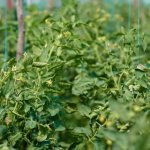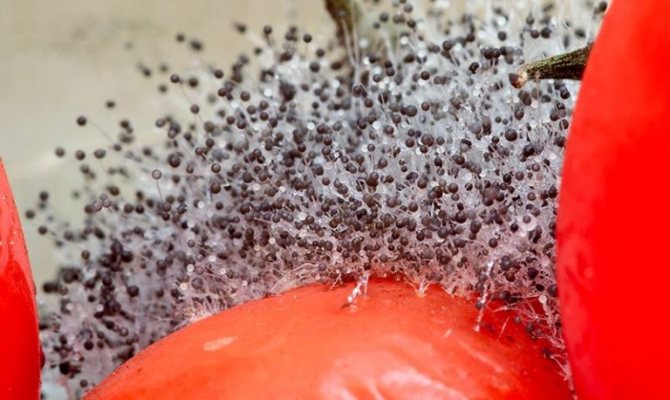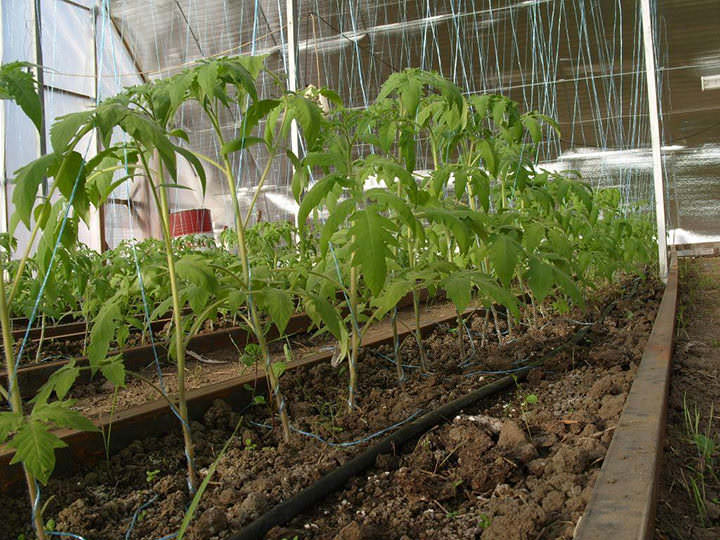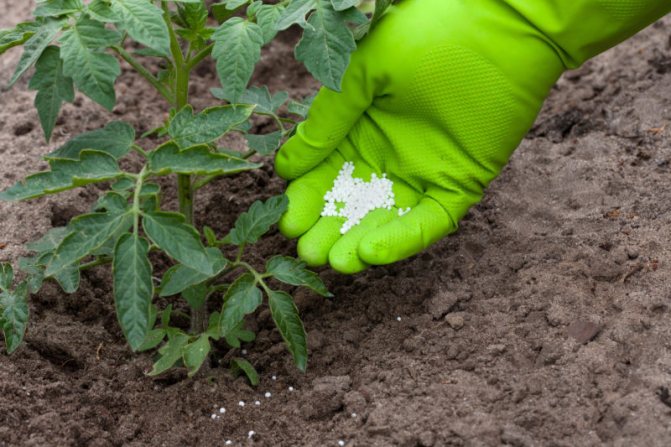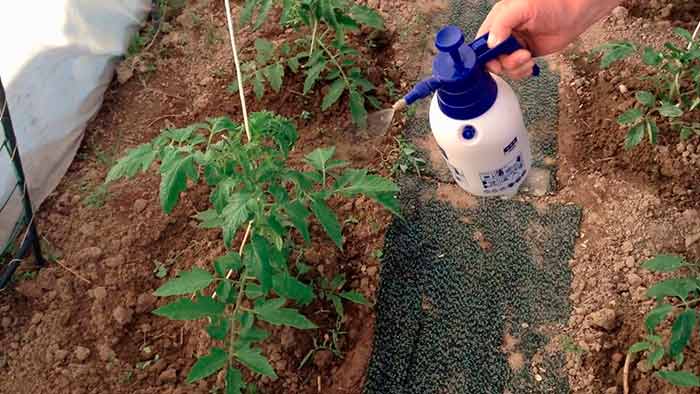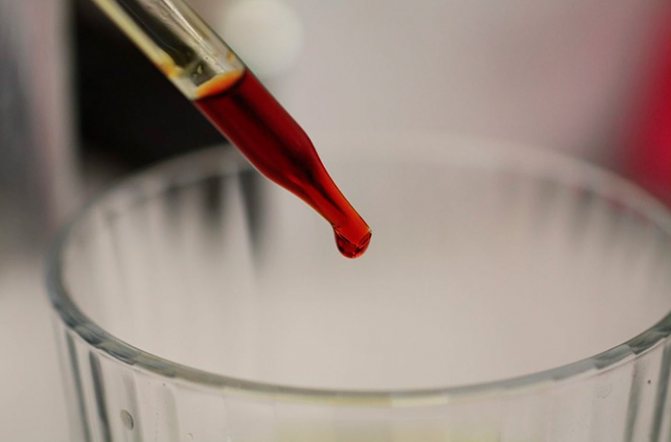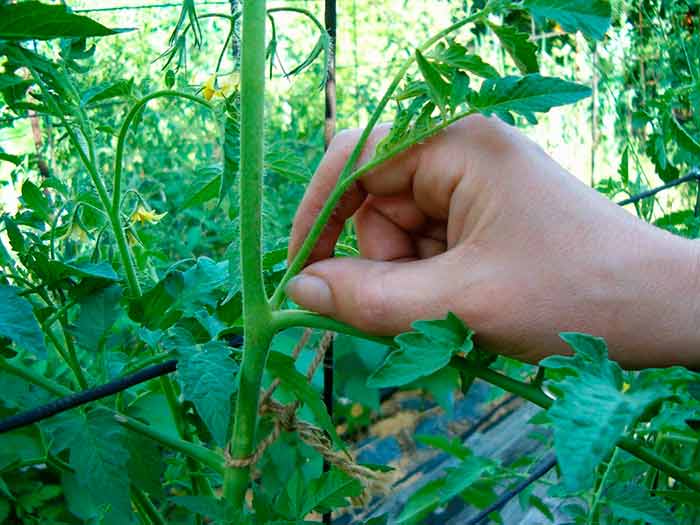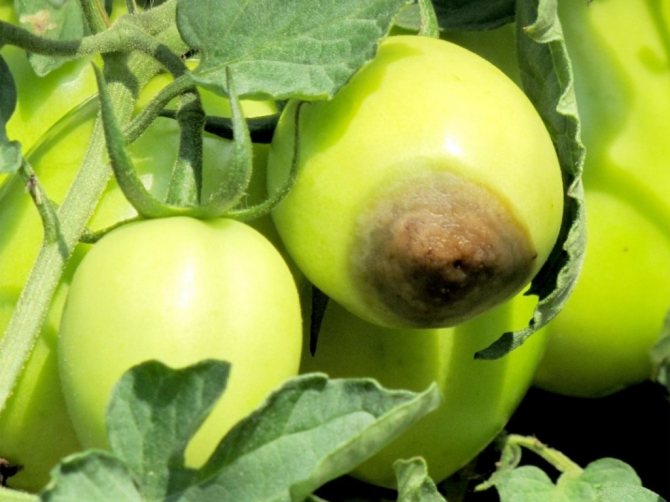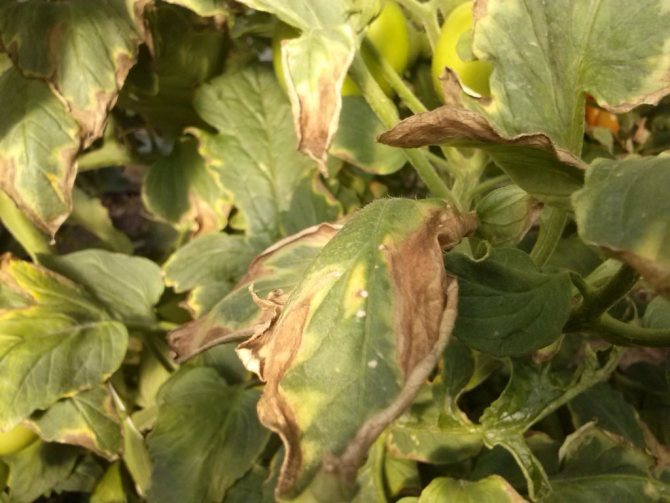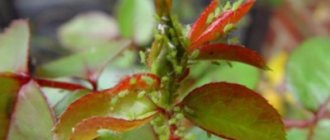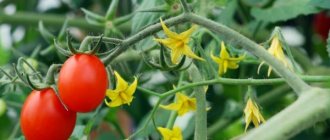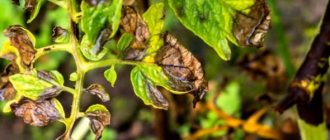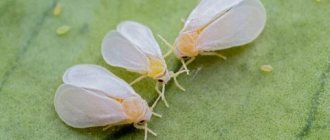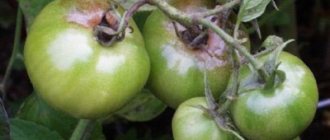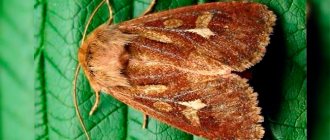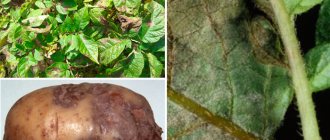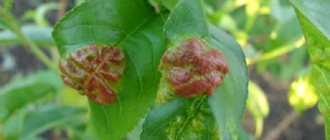Leaves curl both in tomatoes that grow in the greenhouse and those that are planted in the open field. This happens as a result of damage to the root system, lack of pinching, improper watering, violation of the temperature regime. To understand why the leaves of tomatoes curl, one must be able to determine the level of lack or excess of fertilizers and the presence of crop diseases, since this is also the cause of their deformation.
Leaves curl both in tomatoes that grow in the greenhouse and those that are planted in the open field. Illustration for this article is used under a standard license.
Causes of leaf mold
The disease is caused by the fungus Cladosporium fulvum Cooke. In a dormant state (conidia), the fungus can retain the ability to develop for almost a year, without losing it either as a result of exposure to low temperatures or after a long stay in a dry environment. The pathogen safely hibernates in the ground, even if the garden bed is cleared of plant debris, and returns to the tomatoes the next season.
Conidia of the fungus infect the soil to a depth of no more than 10 cm, therefore, in the event of a disease after harvesting, it is recommended to replace this layer of soil in the greenhouse.
Fungi can penetrate into indoor ground together with water, air, on work tools and clothing. Once in a favorable environment, the conidia of the fungus that have fallen on plants, including weeds, begin to germinate.
Air humidity is critical for the causative agent of cladosporiosis. To activate conidia, this indicator must be above 80% (the optimal level is 90-95%). At a suitable temperature (within + 22 ... + 25 ° C), the fungus begins to spread rapidly throughout the tomato planting.
As a rule, the fungus affects weakened plants, often the stress experienced by them due to a sharp jump in temperatures (with improper ventilation, watering with cold water) becomes a "trigger" for the disease of tomatoes in the greenhouse.
There is no infection, but the disease is
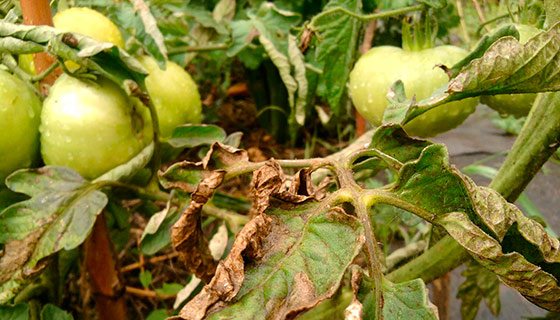
The main causes of non-infectious diseases are violations in the care of tomatoes, non-compliance with basic agricultural practices.
At the same time, even experienced gardeners can get such unpleasant "surprises" without taking preventive measures due to lack of time or violating agricultural practices.
Often, illnesses are also caused by unfavorable weather conditions (hot or rainy summers, long periods of low temperatures).
Top rot
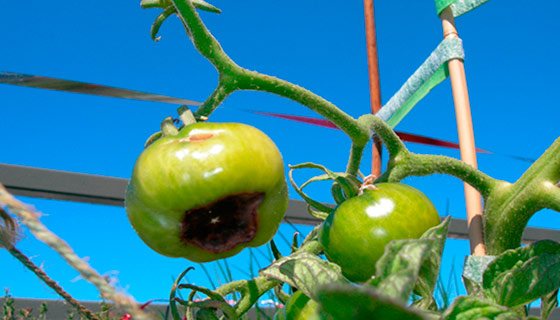

With this disease, the fruits in the lower part have a brown spot, which gives the tomatoes a very unattractive appearance.
Fungi may appear in the area affected by rot, and then the disease passes into an already more severe and advanced stage.
Treatment:
- Timely watering of tomato bushes.
- Compliance with the ventilation regime (in greenhouses),
- Balanced feeding, the use of formulations containing a sufficient amount of calcium.
- Use for growing hybrids and varieties of tomatoes that are resistant to top rot.
Fruit cracking


The peel of tomatoes cracks, which can lead to the ingestion of various infections and disease.
To avoid this, it is necessary to avoid overfeeding tomato bushes with nitrogen, irregular watering.The tomato may burst after pinching, pinching, removing leaves, due to the strong pressure of the water coming in after watering.
Hollowness of tomatoes
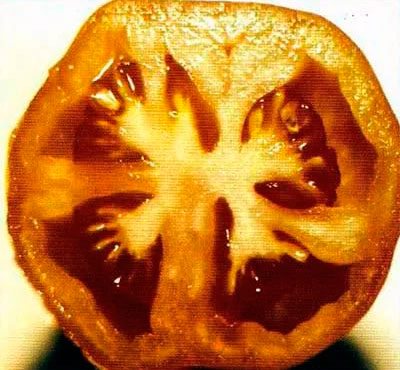

There are no seeds inside the fruit, the pulp has voids. The fruit looks unusual on the cut, the tomatoes grow defective, tough.
The causes of this disease are hot weather and irregular watering, lack of fertilizing, which contain potassium, improper growing conditions (especially for tomatoes that grow in greenhouses). Often the temperature regime is not observed, in the greenhouse there is poor lighting, high humidity, pollination and fruit setting is slow or completely absent.
To avoid the appearance of such hollow tomatoes will only allow compliance with the regime and proper care.
Sunburn
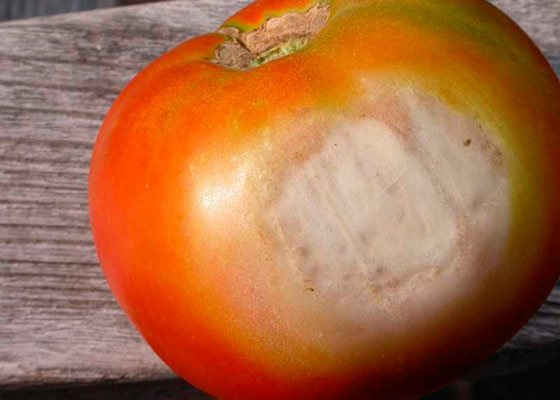

In hot and dry summers, in abnormal weather (which is not uncommon now), tomatoes can get sunburn.
This manifests itself in the form of whitish spots, which later begin to darken.
Bumps, furrows appear on the skin of the fruit, the taste and juiciness of tomatoes are lost.
To avoid such burns, you need to take care of covering the tomato bushes. Any nonwovens (agryl, spunbond and others) are perfect for this,
Cladosporium symptoms
Signs of the disease in tomatoes most often become noticeable to the gardener at the stage of flowering and the formation of ovaries. The very first symptom - light green spots on the leaves - appears even during the budding period. Gradually, the spots acquire a yellow color, starting to stand out against a green background, a gray bloom forms on the back of the leaf in the corresponding areas. Over time, the plaque becomes denser, velvety to the touch, its color changes towards a brownish-brown hue.
Affected leaves become deformed, turn yellow and dry out. The plant, losing its foliage, weakens and withers due to the disruption of the processes of photosynthesis and, accordingly, the nutrition of its cells. Even if a diseased bush does not die, it will not be able to grow a full-fledged crop - the fruits will be small, although edible. Usually, the fungus affects only the leaves, but can spread to flowers and ovaries.
Non-infectious (physiological) diseases
Top rot
Physiological disease of tomatoes caused by lack of calcium and water.
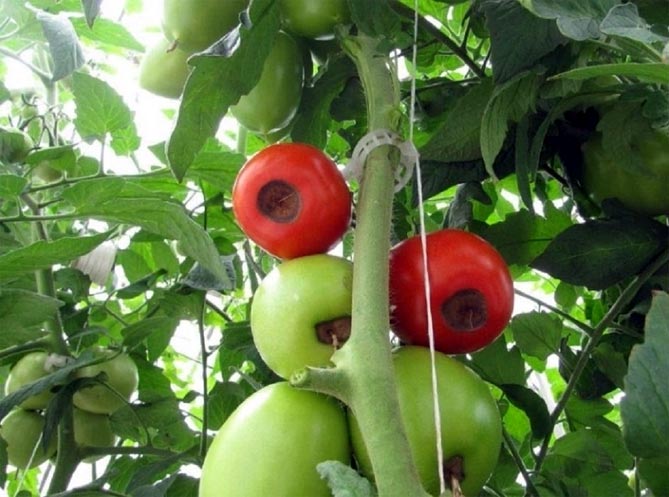

| The reasons | The disease appears due to inadequate care, poor growing conditions. Main reasons:
|
| Symptoms | Dark brown or dark spots appear on the tops of the fruit, which over time can expand and cover a large area of the tomato. The spots sink, the flesh underneath is firm and dry. |
| Risk factors | Disease of tomatoes more often occurs during drought or high soil and air temperatures. It is rarely caused by a physical lack of calcium in the soil, mainly due to disturbances in the absorption and transport of this element in the plant. |
| Prevention | Large fluctuations in temperature, salinity, overdrying or excessive flooding of the soil, too low a pH and accumulation of potassium and nitrogen ions are just some of the factors that hinder the absorption of calcium. In such situations, the only effective and quick way to deliver calcium is the use of fertilizers in the form of foliar dressing (leaf spraying). |
| Disease protection measures | During the formation and setting of fruits, it is recommended to spray with calcium fertilizers. One of the proposed solutions is the liquid fertilizer EKOLIST Calcium - a chlorine-free calcium fertilizer concentrate with nitrogen, magnesium and a set of trace elements, which, in addition to replenishing the lack of calcium, improves plant metabolism, providing them with all the necessary trace elements. |
Fruit cracking
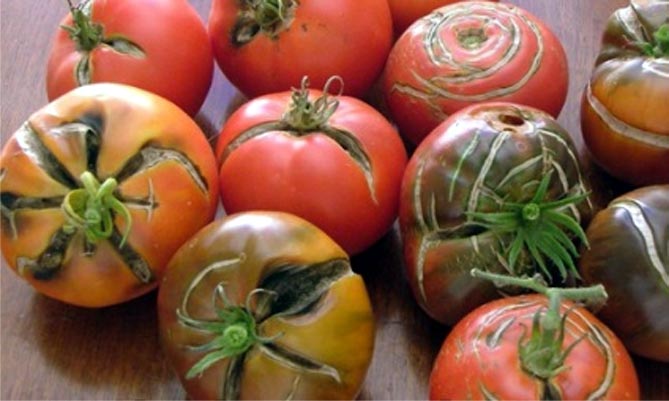

| The reasons | Tomato fruit cracking is caused by:
|
| Prevention | Recommended:
|
Falling flowers and ovary
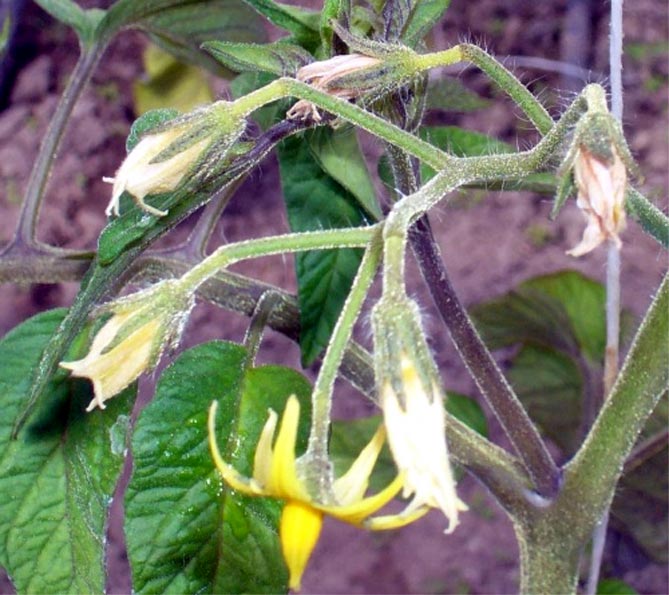

| The reasons |
|
| Prevention | When transplanting seedlings with the addition of nitrogen fertilizers to the hole, poor fruit set can be provoked. |
Uneven fruit color
Disturbances in the growth and development of tomato plants often lead to uneven fruit color. Regardless of the unusual atmospheric and agrotechnical conditions, staining disorders can also be the result of various infectious diseases.
| The reasons |
|
| Prevention | Proper fertilization, shading |
High temperature effects - burns
When the weather changes dramatically, there is a sharp drop in temperature. With the onset of heat, the temperature at noon exceeds 30 ° C, and in greenhouses, with insufficient ventilation and shading, it is 15 ° C higher than outside. In such conditions, almost all metabolic processes at the level of plant cells and tissues are disrupted. The substances necessary for growth do not reach the fruit in sufficient quantities.
Fruits do not color evenly because lycopene, which makes tomato fruits red, is not produced when temperatures exceed 32 ° C for several hours a day. Such a high temperature does not interfere with the formation of carotene and brick spots appear on the fruits. These symptoms usually occur when the fruit is close to glass panes and is not covered with leaves. Sometimes white spots may appear if, under the influence of too high a temperature, the tissues of the fruits heated by the sun die.
Photo. Sunburn sometimes resembles the symptoms of dry rot of tomatoes caused by a lack of calcium or water, with the difference that with dry rot the necrosis is brown and sometimes black. There is a darkening of part of the fetus as a result of sunburn, the lack of lycopene synthesis causes the yellow color of the fetus.


Potassium deficiency
Uneven coloration is caused by a deficiency of potassium, the lack of which leads to inhibition of lycopene synthesis and a delay in the breakdown of chlorophyll in ripening fruits.
The following symptoms - green and yellow spots (pictured below) - are aggravated by excess nitrogen and often occur at the base of the fetus.
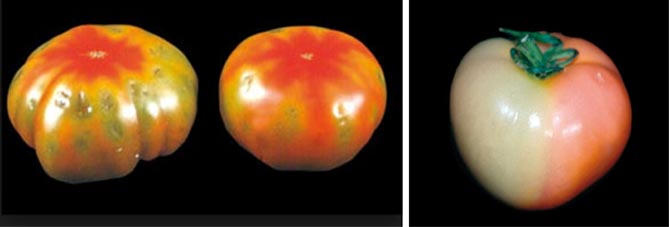

Photo. An orange heel, caused by a lack of potassium, is sometimes accompanied by arcuate cracks resulting from a later ripening of the heel than the rest of the fetus.
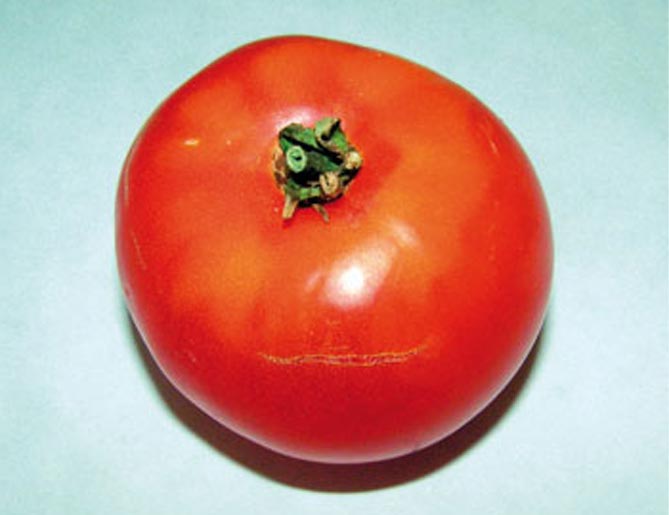

Tomato fruits have an increased need for potassium - one plant consumes up to 25 g of this element during the growing season. The demand for potassium is higher in autumn when there is a lack of light (in November) than in summer. The potassium content in the leaves should be 4.5-7% of dry matter, and in December and November it can reach 8%. Too abundant potassium application to prevent uneven fruit color, sometimes reduces the yield by 10%.
Potassium deficiency is evidenced by yellowing and browning of the edges of the leaves, the growth of brushes at an acute angle, which causes them to peel off and break off under the weight of the fruit. Potassium deficient tomatoes are less tasty due to the low content of sugars, acids, dry matter.
The physiological abnormalities in fruit coloration described above can be confused with the effects of certain pathogens. Internal darkening can be caused by bacteria from the genus Erwinia, Bacillus and Aerobacter. Similar symptoms are also caused by the mosaic virus.
Gold dots are a sign of excess calcium
Microscopic examination showed that in the place where the golden dots appear - orange, glowing spots on the fruits of tomatoes - under the skin are pulp cells filled with crystalline forms of calcium. This is a relatively recent problem in tomato production. One of its causes is excessive calcium supplementation or excessive absorption of this ingredient by plants.
Photo. "Golden dots" on tomatoes are a sign of excess calcium.
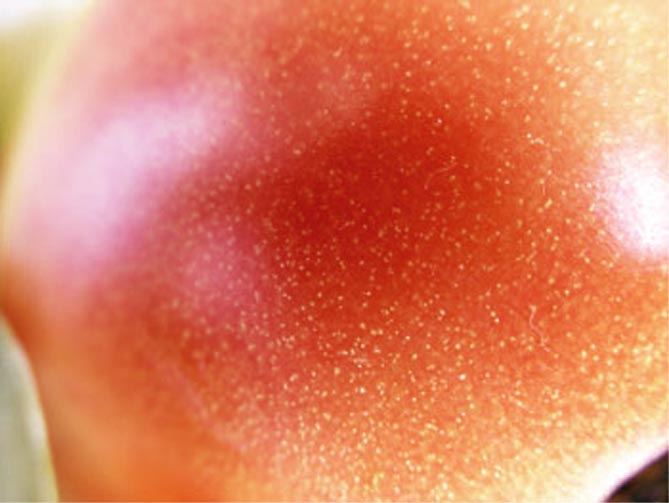

Pillar
The main causes of the disease are high air and soil temperatures. To prevent disease, tomatoes should be shaded during the hottest hours of the day, choosing appropriate planting sites. Mulching of moist row spacings has a positive effect.
Leaf mold treatment
Cladosporia is one of those diseases in which it is critical to start treatment as early as possible. If it is possible to detect a lesion and take action at a stage when the spots on the leaves are just beginning to acquire a yellowish color, the crop can usually be preserved without loss.
Chemicals
Fungicide treatment is the most reliable means of combating tomato brown spot. In the later stages of the development of the disease, only chemical preparations are able to save the crop and the plants themselves. Processing is allowed no later than 3 weeks before the removal of fruits from the bushes.
It is recommended to use preparations against leaf mold:
| A drug | Volume of substance per 10 l of water | Consumption of ready-made solution per 1 hundred square meters |
| "Poliram" | 41 g | 6 l |
| "Abiga Peak" | 50 g | 10 l |
| "Tsineb" | 40 g | 6-8 l |
| "Quadris" | 6 ml | 10 l |
| "Bravo" | 60 ml | 4-6 l |
| "Polykhom" | 30 g | 10 l |
| "HOM" | 40 g | 10L |
Spraying should be repeated after 10-15 days.
Folk remedies
In the early stages of the development of the disease, the use of folk remedies may be sufficient to suppress the activity of the fungus, although there is a risk that treatment will not help. Folk remedies can act as an effective prevention of leaf mold for plants in greenhouses, where fungus appeared in previous seasons.
- Iodine. To prepare the solution, add 40 drops of iodine to a bucket of water and mix. With a solution of iodine, you can not only spray the bushes, but also water the soil. The liquid must penetrate to a depth of at least 10 cm.
The popular recipe with iodine and potassium chloride for watering tomatoes affected by cladosporiosis should not be used, since the culture does not tolerate chlorine well. But the agent can be used for the autumn soil treatment against the fungus, provided that the shelter is removed for the winter (chlorine is faster than potassium is washed out by precipitation, therefore, potassium chloride in this case will also act as a fertilizer). To prepare the product, 30 g of potassium chloride should be added to 10 liters of iodine solution.
- Milk products. For spraying, both regular and sour milk are suitable, milk whey acts most effectively against brown spot. 1 part of the product must be diluted with 10 liters of water. To enhance the effect of milk, 30 drops of iodine should be added to the solution.
- Potassium permanganate. The bushes are sprayed and watered with a light pink solution of potassium permanganate.
- Ash. Boil 300 g of ash in 3 liters of water for 20 minutes, then add 7 liters of water and leave to infuse for 3 days. The tool can be used to water the soil and spray the bushes. It is recommended to add a little soap to the spray liquid (this solution adheres better to the leaves and stems of plants). Watering with an ash solution is most effective if you alternate them with watering with potassium permanganate (irrigations are performed once 7 days, each of the funds is applied once every 2 weeks).
Excess or lack of fertilizer
Tomato leaves curl with an excess of zinc, manganese, nitrogen and a lack of calcium, phosphorus, copper.
Moisturizing the soil with a solution of water and superphosphate (5 l / 90 g) will help to eliminate the lack of phosphorus.The lack of copper will be compensated by the processing of tomatoes with HOM, Oxykhom preparations. A solution of 22 g of calcium nitrate, 400 g of wood ash, 12 g of urea will help nourish the plants with calcium. All components are added to a bucket of water, the resulting composition will be sufficient for processing 4 m².
Disease prevention
Leaf mold prevention measures should be divided into 2 groups: prevention of the first appearance and prevention of the return of the disease.
Measures from the first group are common to prevent the occurrence of fungal diseases and a number of pests in the greenhouse:
- After harvesting, you need to immediately remove the tops, weeds, remaining fruits and other plant residues from the beds.
- In the fall, it is necessary to carry out a deep digging of the soil. It is advisable to repeat the procedure in the spring.
- Plant seedlings in a greenhouse, keeping a distance of 30 cm between the bushes. With a thickened planting, the disease spreads faster from one plant to another.
- Ventilate the greenhouse regularly to avoid excessive moisture build-up.
Mulching plantings with peat will help to lower the humidity in the greenhouse.
- Avoid excess moisture in the soil by controlling watering.
If the fungus has already been noted on tomatoes in the greenhouse, regardless of the success of the treatment undertaken, care should be taken to protect the greenhouse and plantings in it from cladosporiosis in the new season. It is rarely possible to completely remove the fungus the first time, but with the right action, it is possible, at least, to suppress the awakening of conidia.
In this case, it is necessary:
- Disinfect the greenhouse. One of the favorite wintering places for the fungus is the wooden frame of the shelter. Treatment with formalin (200 cm3 of 40% substance per bucket of water) and fumigation with sulfur (40-50 g per 1m3) will be effective.
- Carry out pre-sowing seed treatment. Thiram or Fentiuram is suitable for the fight against leaf mold.
- Treat tomatoes with a solution of copper oxychloride (0.4%) or Bordeaux liquid (1%) during the active growing season. Then, every 10-15 days, spray with an infusion of garlic or the antibiotic "Trichopol" (1 tablet per liter of water).
- Water the tomatoes at the beginning of the growing season with a solution of the drug "Metronidazole" (dissolve 15 tablets in 1 liter of water).
- To carry out 3 treatments of tomatoes with the antimicrobial agent "Furacilin" (1 tablet per 1 liter) during the season.
- Preparations containing bacteria that feed on fungi work well against disease. Throughout the growing season, including the fruiting period, it is worth treating the planting (withstanding the breaks specified in the instructions) with the preparations Fitosporin-M, Fitovlavin 300, Pseudobacterin-2 and Integral.
If it is not possible to defeat the fungus, it remains to choose for growing varieties of tomatoes that are not susceptible or show high resistance to the disease:
- Admiralteysky;
- Gardener;
- Black Moor;
- Delicacy;
- Paradisaic delight;
- Giant;
- Red Arrow;
- Cherry red.
Among the hybrids, you can find more resistant to cladosporiosis:
- Our Masha;
- Favorite;
- Pink Paradise;
- Energy;
- Titanic;
- Centaur;
- Kostroma;
- Torbay;
- Red Comet;
- Premier;
- Funtik;
- Victoria;
- Margarita;
- Torbay;
- Flamingo;
- Vitador;
- Malika;
- Eupator;
- Octopus;
- Donna Rose;
- Northern Express;
- Business lady.
The fungus that causes leaf mildew is very difficult to remove from the greenhouse and can remind of itself even after several years. Therefore, in the event of a disease, it is recommended to switch to the cultivation of resistant varieties. Also, do not forget about disinfecting clothes and garden tools, so as not to spread the disease to plants in other greenhouses.
Mold on tomatoes in a greenhouse is a disease caused by fungal spores. There are several types of fungal infections, but the mechanism of their action is the same: these harmful microorganisms penetrate the plant, feed on its tissues and thereby inhibit the vital activity of the culture. Mold appears in the greenhouse much more often than in open beds, and affects seedlings en masse. If you do not start the fight in time, the disease can quickly spread to all the sprouts and completely destroy the tomatoes in the greenhouse.
Why does mold appear on tomatoes in a greenhouse?
The reason is the atmosphere in the greenhouse - humid and warm.The closed space of mini-tropics is most conducive to mold settling in the ground, on parts of greenhouse structures, from where it migrates to plants.
Varieties of mold on tomatoes in the greenhouse
Most often, tomatoes in greenhouses are affected by:
- late blight (late blight rot);
How to get rid of mold on seedlings
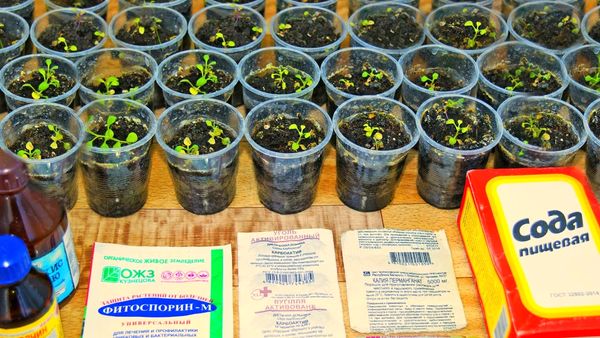

There are several ways to get rid of mold. It all depends only on how contaminated the soil is. But there are some general tips that can help without using any chemical or folk remedies. It:
- loosening the soil;
- replacing the contaminated part of the soil with a new one;
- reducing the amount of water during irrigation;
- airing.
If small foci of mold are found on the ground, quartz sand can be used for the outer layer of the soil.
When drying the soil, there is no guarantee that yellow mold that develops in high humidity conditions will be completely defeated. Mold fungi will stop their development for some time, but with new watering they will start active reproduction again, growing further and further. Mold on peat pots can be simply removed along with a layer of soil. And also sprinkle with crushed activated charcoal tablets.
Special drugs
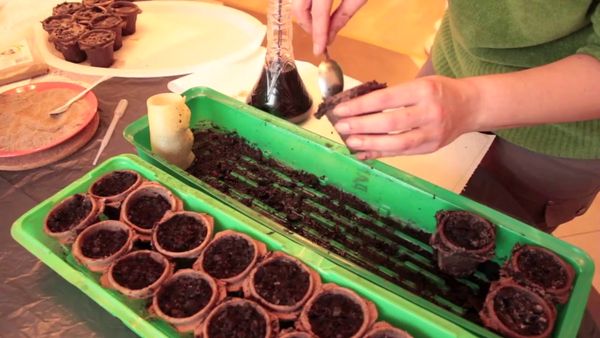

To completely get rid of a fungal infection, you can resort to using chemicals created by specialists:
- Fitosporin;
- Fundazol;
- Oxyhom;
- Mikosan;
- Vitaros.
The preparations must be dissolved in water. And before you work the land, pay attention to the dosage indicated by the manufacturer. And the resulting solution is watered with seedlings of cucumbers or any other plants. After watering, you need to loosen the ground a little so that it dries out.
And also after using chemicals, you can sprinkle the soil with ash or sand as a supplement.
Folk remedies
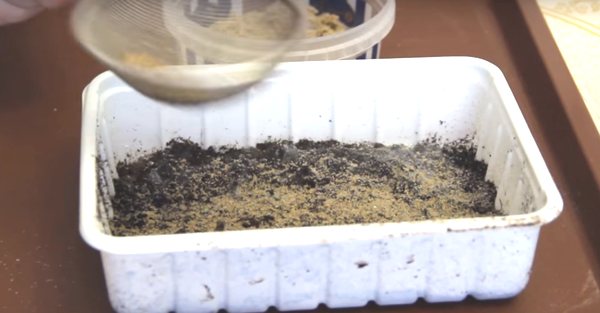

After applying any means, care must be taken to ensure that molds no longer develop. To do this, you can use several alternative methods available to everyone:
- Regular baking soda will be a reliable aid in the fight against mycelium. Soda has a detrimental effect on the fungus and prevents it from growing.
- Add river sand to the top layer of the earth. First, it must be calcined and then added to the soil. Thanks to this, you can most likely get rid of the problem.
- Sprinkle the earth with activated charcoal (can be replaced with wood ash). This will provide reliable protection against pathogenic microorganisms.
Prevention of mold in the greenhouse on tomatoes
Greenhouses need to be regularly ventilated, before the beginning of the season and at the end of it, treat structures with fungicides. The soil must be regularly renewed and disinfected. When pruning and other procedures, you need to wipe the tools with alcohol and lubricate the trimmed parts of the plant.


Preventive treatments are carried out with folk remedies - garlic tincture, onion peel decoction, iodine solution.
In order not to mold the tomatoes in the jars, the workpieces are placed in sterilized jars, reporting there seasonings, spices and vegetables rich in phytoncides - horseradish, garlic, onions, currant leaves, etc. But when a fungus appears in an open jar, the product is most likely hopelessly spoiled, and it's not worth eating. Due to the delicate consistency of tomatoes, they will quickly become saturated with a moldy smell, and their taste will deteriorate.
Did you like the article? Like it ♥, subscribe to our channel and you will be one of the first to know about new publications!
And if you have something to share - leave your comments! Your feedback is very important to us!
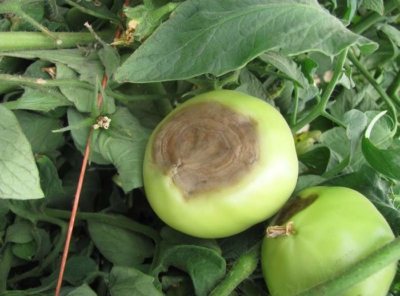

Like all vegetable crops, tomatoes are susceptible to a variety of diseases that are caused by pathogenic fungi. Although therapies have been developed for these diseases, most of the measures are preventive in nature.Plants affected by the fungus, even after treatment, can no longer recover completely, which confirms the old rule - the disease is easier to prevent than to cure.
reason 8. Features of the variety
In some tomato varieties, leaf curling is a genetic feature. Basically, cherry and small-fruited varieties of tomatoes are prone to this.
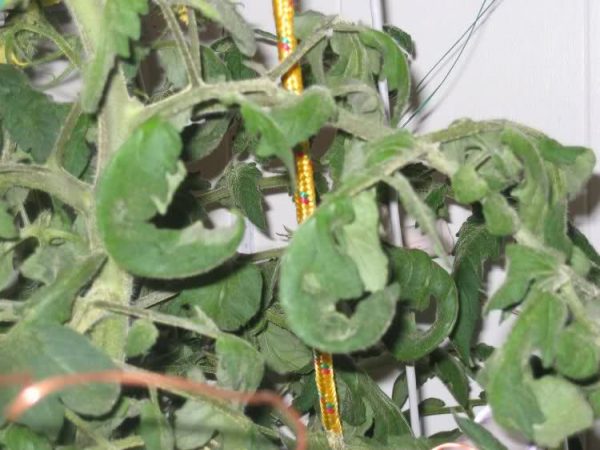

There are also such tomatoes.
Usually, in this case, the leaf blade is twisted downward, forming a "chicken foot". But in some varieties, the leaves can curl upward. In this case, nothing needs to be done, neither feeding, nor watering, nor airing will help here. It's just a feature of the variety.
Causative agents
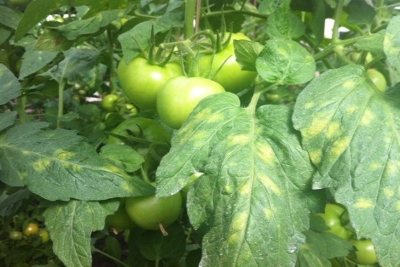

The causative agents of fungal diseases are microscopic phytopathogenic fungi. They affect not only tomatoes, but also other vegetable crops. These include:
- Phytophthora infestans - the causative agent of late blight.
- Erysiphe communis and Leveillula taurica - pathogens of powdery mildew.
- Cladosporium fulvum Cooke - the causative agent of brown spot.
- Phoma destructiva - the causative agent of brown rot.
- Didymella lycopersici - causative agent of stem rot.
- Didymella lycopersici and Pythium debaryanum - causative agents of root rot or rhizoctonia.
- Colletotrichum phomoides - the causative agent of anthracosis.
With rare exceptions, all these pathogenic fungi prefer dampness, and with excessive watering they begin to develop rapidly. The fight against them is effective only if measures are taken at the very beginning. If the infection has become an avalanche, it remains only to calculate the losses.
Features of the course of the disease
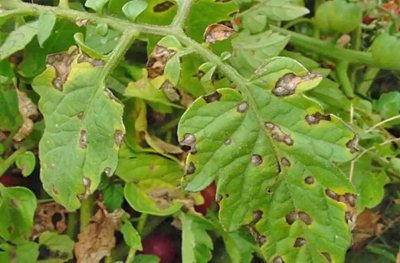

Pathogenic fungi affect all parts of the plant. On seedlings and adult plants, spots of various colors appear and spread, plants turn black, dry, wither, fruits rot. Despite the general similarity, the symptoms of each disease have their own specifics. A timely diagnosis can reduce the damage to some extent.
Fungal diseases are dangerous because their spread is difficult to control... They not only significantly reduce the yield, but they can also destroy the remaining, apparently unaffected tomatoes, already laid for storage.
Control methods
Unfortunately, there are no radical remedies against fungal diseases of tomatoes. Modern methods of dealing with this scourge can be divided into three classes.
- Agrotechnical methods:
- Correct tillage before winter. In the fall, you should dig up the site well, but do not harrow it, so that the spores, if possible, die from frost.
- It is undesirable to plant tomatoes after potatoes, legumes and pumpkin seeds. It is better if the predecessors are cucumbers or onions.
- Before planting, it is necessary to process (pickle) both the seeds and the soil itself in the future bed with tomatoes.
- Chemical method - treatment with systemic fungicides throughout the growing season - from planting to the moment when two to three weeks remain before harvesting.
- Biological method - the use of beneficial microorganisms that are soil antagonists of the fungus (trichoderma), and antibiotics (trichothecin).
How to distinguish a fungus?
To choose the right treatment strategy, it is necessary to determine the nature of the disease as early as possible. It is necessary to be guided not by any one criterion, but by their totality. Common signs of fungal infection in tomatoes:
In the photo you can see what the fungus looks like on tomatoes:
Insects - tomato pests
Certain types of insects cause the death of tomatoes. Pests like aphids or spider mites like to settle on the back of the leaf, feed on plant juices, which is why there is a gradual drying out, twisting of the tops.
How to fight
They get rid of insects by spraying with special preparations (insecticides).Bushes should be carefully processed from all sides.


How can plants be treated?
- 1% Bordeaux liquid solution... Plants are sprayed regularly at intervals of 7-8 days.
- "Hom" (copper oxychloride)... A well-known highly effective drug. It is used in dilution of 40 g per 10 liters of water. The frequency of processing is from 2 to 6 times with an interval of 10-14 days.
- "Polykhom"... Fungicide of complex action. Effective against a wide variety of fungal diseases. Inexpensive, harmless to bees and bumblebees.
- "Zaslon", "Barrier", "Planriz"... Microbiological preparations. In addition to direct suppression of fungi, they help prevent diseases and reduce the level of nitrates in fruits.
In addition to those listed, there are many other fungicide preparations, different in purpose and effectiveness:
- Ditahem DG.
- Acrobatem MZ.
- "R>Attention: All fungicides must be used strictly as intended and in strict accordance with the instructions.
Interesting facts about mold
This is a type of mushroom that combines the characteristics of both plants and animals. There are rudiments of brain activity. It is unusually tenacious, its age reaches 200 million years. Not afraid of radiation, traveled into space, while surviving and became even more aggressive. It is capable of neutralizing oil products, absorbing toxins, and is also used in the food industry.
You can get rid of diseases only by knowing the correct methods for eliminating them, and the tomato harvest will continue to delight you.
The most common diseases
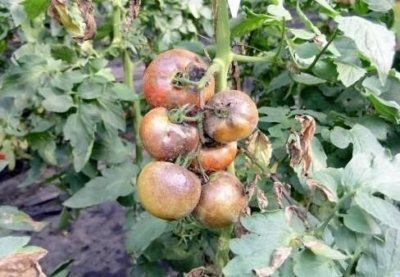

There are many fungal diseases of tomatoes. It is hardly possible to single out one of them, the “most dangerous” one.
- Late blight... A very dangerous disease. Can completely ruin the harvest. It affects the entire aerial part of the plant, causing tissue necrosis and rot. Spores persist in the remains of dead plants and soil.
- Gray rot... It affects all varieties and hybrids of tomatoes. Starting from the stems, it captures the entire plant, causing necrosis and death of the plant. High humidity contributes to the spread.
- Blackleg (root rot)... Distributed mainly in greenhouses (on the substrate), in the open field - in waterlogged areas. The damage done is not very significant.
- Alternaria... It develops at elevated temperatures and high humidity. It is capable of destroying up to half of the harvest. Black spots appear on the leaves and fruits. The fungus remains in plant debris.
- Septoria, or white spot... A very dangerous disease that can destroy up to half of the crop. It also affects seedlings. Dirty white spots with a dark border appear on the leaves. There are no completely resistant varieties. Hybrids Platus F1, Worthy F1, Divo F1, Golden Fleece F1, etc. are affected to a lesser extent.
- Cladosporium, aka olive or brown spot... Develops at elevated temperatures. Orange spots appear on the leaves, then a dark bloom. Resistant varieties - Eupator, Zhenaros, Raisa, Kunero, Partner Semko F1, Yvon.
Diseases of tomatoes caused by bacteria
A large and varied group of microorganisms on the planet is bacteria. They cause the most significant damage to agriculture, regardless of their varieties and names. Bacterial diseases are more difficult to treat than viruses. Disease pathogens affect the roots, leaves, stems and fruits of plants. Bacteria can be considered the most viable microorganisms - they survive in the soil for two to three seasons, are carried through the air and in water, and are spread by insects and birds.
Any plants on the site can become the object of the "attack" of bacteria, and gardeners should take this into account in the fight against the disease. In addition to treating infected plants with visible signs of disease, prophylaxis on healthy-looking plants is necessary.
How to recognize the presence of bacteria on tomatoes?
Tomato bacterial cancer
The cause of the appearance of the disease is bacteria that penetrate the plant through damaged leaves and stems, sometimes through the roots, which are damaged underground by pests of tomatoes, or waterlogging and decay of the roots occurs in the underground part, due to a violation of the irrigation and aeration of the soil.
Optimal conditions for the development of the disease are temperatures of 18-240C and high humidity, over 80%.
Secondary infection occurs in the absence of disinfection of equipment used for seedlings, as well as for plant care. The bacteria persist in the soil for up to 5 years, and are carried by infected seeds and weeds.
In the initial stage, the disease manifests itself in leaf rolling, and this phase is the signal to start treatment. The next phase is stem cracking, deformation. Dotted white spots appear on the fruits. A characteristic symptom of the disease is the appearance of a yellow-brown sap, which is released when pressed on the stems.
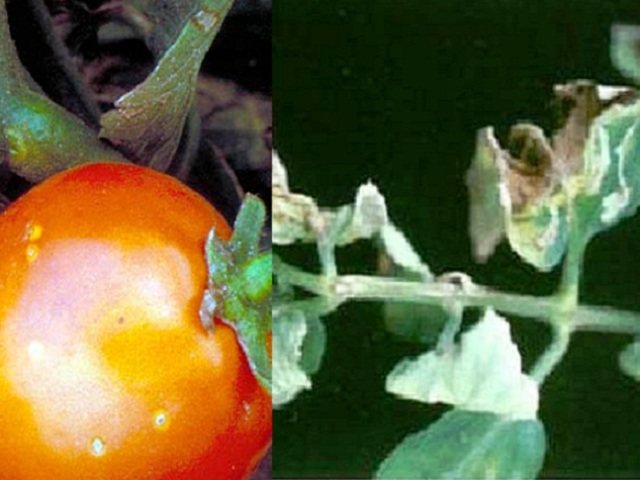

If it is difficult to establish a "diagnosis", but the first noticeable signs clearly indicate the presence of infection in tomatoes, treat with universal drugs - in any case, such support will not harm the plants.
Advice! Give preference to biological treatments, and use chemicals as a last resort.
Bacterial spotting (spotting)
Long-term unfavorable conditions for growing tomatoes and violation of agricultural requirements are fertile soil for the development of bacteria. In cool and rainy summers, brown to black spots surrounded by a yellow halo may form on the leaves, stems and fruits of tomatoes. They gradually grow and lead to the death of leaves, spoilage of fruits at any stage of maturity, a significant decrease in yield and shelf life.
The worst thing is that bacteria of this species quickly spread to all vegetable and fruit and berry plants. Pathogenic microorganisms persist for several seasons, are spread by seeds, and therefore are difficult to treat.
Today, microbiologists know three races of bacteria in this group. In addition to the one described above, there are bacteria that cause similar symptoms of tomato disease, but they form bulging watery spots surrounded by a white halo, which, when dried, crack and form black dots with an oily bloom, or, conversely, concave inward of the fruit, with a scaly surface. The second group of bacteria is also spread by weeds and pests of tomatoes.


Bacterial (sclerocial) wilting
There are at least three types of tomato pathogens. It is possible to identify tomato infestation by its appearance, drooping "for no reason", with normal watering, of the lower leaves. If the cut stem of such a plant is immersed in water, you can see a milky cloudiness. In a later stage, the entire bush "withers", the stems become hollow, and mucus that has a yellow-brown color is released from them. This tomato disease is the most dangerous because it is transmitted by all possible means, and bacteria "master" not only tomato beds, but also more than two hundred species of garden and horticultural crops.
The disease is typical for tropical and subtropical regions, with high temperatures and humidity, which is why it is also called southern wilting.


Pith necrosis
The disease can be noticed by wilting and yellowing of the upper leaves, when fruits appear on the first cluster, which begin to deform, become covered with black depressed spots. On the stems, the spots are watery at first, and then cracked. Sometimes growths or adventitious lateral roots are formed in the cracks. In the longitudinal section of the stem, you can see voids and dying areas covered with dark spots.
The spread of infection is a pathogenic microorganism, but its appearance on tomatoes is associated with an excess of nitrogen in the soil, mechanical damage to the plant. The causative agents of necrosis of the heart are common in all areas of agriculture. Effective treatment is carried out in conjunction with agrotechnical measures.
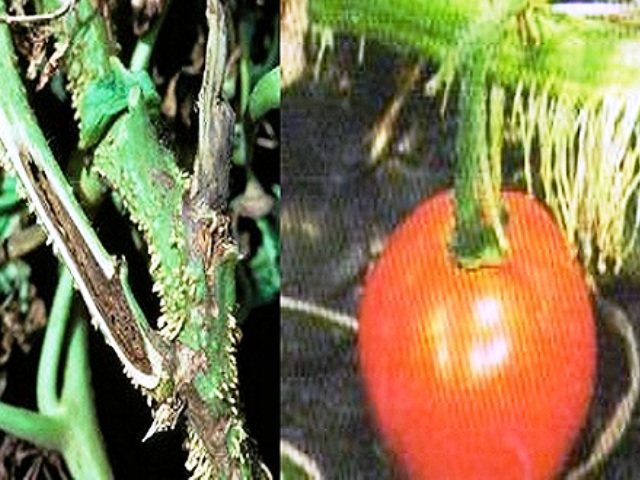

Prevention measures
- Purchase seeds and seedlings only from reliable sources.
- Inspect the plants regularly. At the slightest suspicion, start spraying with harmless means - Bordeaux liquid, etc.
- When planting, observe the distance between the bushes - at least 50 cm.
- Ventilate the greenhouse or greenhouse regularly.
- If possible, use varieties and hybrids resistant to fungal infections.
- In greenhouses, use a sterilized substrate, pickle open ground before planting.
- Once every 2 weeks, treat the soil with biological products containing beneficial microflora - Trichocin, Fitosporin, Alirin-B, Gamair.
Fungal diseases of tomatoes are a very unpleasant thing. Nevertheless, observing simple preventive measures and elementary rules of agricultural technology, it is quite possible, if not to defeat the disease completely, then to minimize the damage. We wish you every success!
«>

